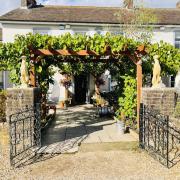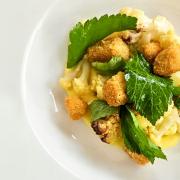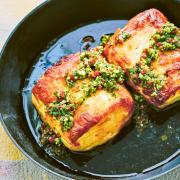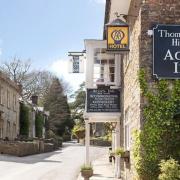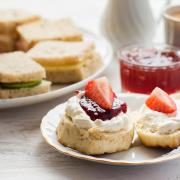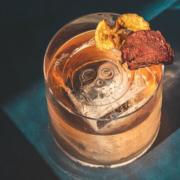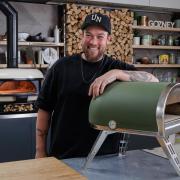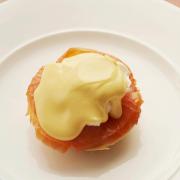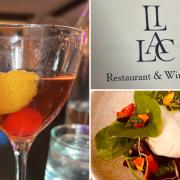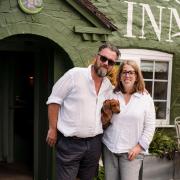After decades of anti-veal campaigns and new legislation, this tender meat is back on the menu but this time it's rose coloured, as Christine McFadden discovers when she met the Sealey family who set up Jurassic Coast Meats in Winfrith Newburgh
Veal Valued
After decades of anti-veal campaigns and new legislation, this tender meat is back on the menu but this time it’s rose coloured, as Christine McFadden discovers ( Photos Scott Morrison)
After years in the wilderness, veal is making a comeback. Chefs can’t get enough of it; it’s on the shelves in farm shops and supermarkets, and sales are beginning to rise. Interestingly, there is a strong history of veal consumption in the UK, particularly before the Second World War. Take a look at your grandmother’s cookbooks and you’ll find dish after dish listed for veal. Classics were Blanquette of Veal (cooked with mushrooms and cream), Wiener Schnitzel (egg and bread-crumbed fried escalope) and the ubiquitous veal and ham pie. Post-war rationing caused a temporary drop in consumption because it was considered wasteful to kill young animals, but the meat regained popularity until the anti-cruelty campaigns of the early 1990s. Despite recent publicity and vastly improved welfare standards, confusion still remains about where veal comes from and whether or not it’s ethical to eat it. To put the record straight, veal is the meat from male calves born to dairy cows. The calves are not considered up-to-the-mark for beef production, so the practice has been to shoot them at birth or export them at a very tender age to mainland Europe. Here, as has been well documented, the calves were inhumanely reared in cramped, dimly lit crates and fed solely on reconstituted milk powder, all in the interests of meeting the demand for tender white veal meat. I was once shown such a beast by a proud farmer in south-west France – it was a deeply disturbing sight.Mercifully, the crate system has long been banned in the UK and, more recently, in the rest of Europe. Nowadays, male calves are legally required to be housed in spacious well-lit barns with plenty of clean straw bedding and freedom to move around. They must be fed a nutritious mixed diet rather than just milk powder. The resulting product is called rose veal, a term that acknowledges the colour of the meat, which in turn stems from the calves’ natural needs for exercise and a balanced diet being met. Rose veal is becoming increasingly available, its consumption championed mainly by producers, but also promoted by the RSPCA and Compassion in World Farming (CIWF) as a relatively humane way of dealing with unwanted bull calves.
Though rearing conditions are generally high in the UK, standards do vary. Curious to see for myself, I visited Fossil Farm near Winfrith Newburgh, where Liz and Eric Sealey and their son, James, specialise in rearing welfare-friendly English rose veal. Their company, Jurassic Coast Meats, was set up in 2008 to market the meat, and now has a fast-growing reputation for supplying top-quality rose veal around the county. The family’s passion for their product is obvious, as is their consideration for the calves’ well-being. They have recently invested an eye-watering sum in a state-of-the-art building designed to cope with a through-put of up to 1,000 calves per year, housed in line with the highest standards of welfare. Efficient ventilation, temperature control and sterile cleaning are key features. Awaiting the finishing touches, the building is already in use, home to new arrivals of week-old calves, sourced on a thrice-weekly basis from neighbouring dairy farms. The calves are weighed, before being penned in pairs in roomy straw-lined bays. Once settled and feeding well, the pairs team up to form two groups of six. At ten weeks, the groups team up again to form a larger group of twelve. Eric emphasises that keeping the calves in the same social group helps them bond and feel at home, and this in turn encourages better feeding. Indeed, the young calves look noticeably calm as we inspect them, eventually becoming curious enough to line up for the camera.
At four months the calves move to larger bays in a separate area. Eric tells me they need gentle handling when being moved. “They respond better to whistling, rather than unnecessary prodding or shouting,” he says. These larger bays are fitted with specially designed ‘ad-lib’ feeding bins, which are constantly topped up with a balanced mix of grain and home-grown ‘crimped’ maize. The animals help themselves from the bins as and when they wish – a far cry from the milk-only restricted feeding once practiced in other parts of Europe. Our last port of call is the area set aside for the big boy calves – a group of not-to-be-messed-with 7-8-month-old beasts, which Eric describes as the equivalent of a gang of rowdy testosterone-fuelled teenagers. At this age they weigh in at an impressive 250kg. James explains that the ratio of meat to bone is at its best at this age and weight, and this is when the calves are slaughtered. On our return to the office, Liz tells me that her biggest learning curve has been selling and marketing. “The public still lack confidence when it comes to veal. It needs that extra push, so I need to be passionate,” she explains, adding that she has been inspired by Sir Alan Sugar and his insistence on the ability to sell. Judging by the crammed order board on the wall, Sir Alan would certainly want Liz on his team.
Cooking rose vealRose veal and beef come from the same animal, but it’s worth bearing in mind that they have different characteristics as far as cooking is concerned. It is better to treat veal like pork, which has a similar dense texture. Rose veal is lean and responds well to moist methods such as pot-roasting and braising, which keep it succulent. It is also delicious grilled or fried but needs quick cooking otherwise it becomes tough. Standing time is crucial too, particularly when roasting. Liz cooks a rib roast at a high heat for 20 minutes, then leaves it to rest in a warm place for as much as an hour. She stresses serving plates must be warm.
SOURCE IT Buying rose vealLook for close-grained brownish-pink meat that is slightly moist but not wet.Choose a cut suitable for the dish:Braising and pot-roasting – shin, shoulder, breastGrilling and frying – escalopes, loin chops, best-end cutlets, rump steakRoasting – boned and rolled loin, leg, best-end of neck
Jurassic Coast Meats supply rose veal to:Clealls of Corfe, 25 East Street, Corfe Castle, BH20 5EECraigs Dairy Farm Shop, East Farm, Osmington, Weymouth, DT3 6EXNorden Farm Shop, Corf Castle, Wareham, BH20 5DSThe Old Chapel Stores, Buckland Newton, DT2 7DAWashingpool Farm Shop, North Allington, Bridport, DT6 5HPWest Holme Farm Shop, Wareham, BH20 6AQ
Rose veal is also available from selected branches of Waitrose.
Jurassic Coast Meats LtdFossil Farm, Winfrith Newburgh, Dorchester, DT2 8DB01305 853355, or click here to go to their website
Recipes
Veal Escalopes with Lemon This classic Italian dish is perfect for a speedy summer supper, with new potatoes and a simple green salad.
Serves 4
Ingredients 4 veal escalopes, weighing about 500g in total1 tbsp vegetable oil50g butterPlain flour for dustingSalt Freshly ground black pepperJuice of 1 lemon, strained4 tbsp water 2 tbsp chopped flat-leaf parsley
Method1 Place each escalope between two sheets of cling film and pound lightly to flatten.2 Heat the oil and two-thirds of the butter in a roomy frying pan over medium-high heat. When the butter is foaming, dredge the escalopes with flour on both sides, shake off the excess and add to the pan. 3 Brown quickly on both sides, then use tongs or a perforated spoon to transfer them to a warm plate, season with salt and pepper.4 Pour the lemon juice and water into the pan. Simmer briskly until slightly reduced, scraping up any tasty sediment from the bottom of the pan. Swirl in the remaining butter and any juices from the meat.5 Return the escalopes to the pan. Reheat quickly, turning to coat with the sauce. Sprinkle with the parsley and serve right away.
Veal and Ham PieThis recipe is from Mark Hix of the Hix Oyser and Fish House in Lyme Regis
For this pie you'll need to first cook a ham hock or ham joint. To do this, soak the joint overnight in water if necessary, drain, then cover with fresh water in a pan. Add a few sprigs of thyme, a bay leaf, 1 or 2 medium onions, peeled and quartered, a couple of sticks of celery and a pinch of peppercorns. Bring to the boil and simmer for 2 hours or so until the ham is tender. Check to see if the water needs topping up. Remove the ham and leave to cool. Keep the stock.
Serves 8-10Ingredients 450g home-cooked ham (see above), cut into rough 1.5cm chunks450g veal rump, cut into rough 1.5 cm chunks4tbsp chopped parsley1 onion, peeled and finely choppedA few sprigs of thyme, finely chopped1tbsp olive oilSalt and freshly ground black pepper3 gelatine leaves
For the hot-water crust150ml water130g lard375g plain flour1/2 tsp salt1 small egg, beatenMethod1 Gently cook the onion in the olive oil with a lid on for 3-4 minutes until soft. Finely chop or mince one-fifth of the veal and one-fifth of the of ham and mix with the chopped onions and parsley and thyme, and season.2 Pre-heat the oven to 200C/gas mark 6. Mix the flour and salt in a bowl and make a well in the centre. Bring the water and lard to the boil in a saucepan, then stir it into the flour with a wooden spoon to form a smooth dough. Leave the dough covered for about 15 minutes or so until it is cooler, less sticky and easier to handle.3 You will need a deep flan ring measuring 18-20cm and about 5cm deep or a similar sized removable-bottomed cake tin. Lightly grease the flan ring and line the bottom with a disc of lightly greased silicone or greaseproof paper. Place it on a baking tray, lined with another piece of lightly greased silicone or greaseproof paper slightly larger than the flan ring.4 Take two-thirds of the dough and on a lightly floured table roll it into a circle about 1/2cm thick and about 25-26cm across, so it is large enough to line the flan ring and overlap the edge by a centimetre or so. Making sure there are no holes in the pastry, place the dough into the flan ring, carefully press into the corners and allow it to just hang over the edge. Roll the remaining dough into a circle just large enough for the top and cut a 2cm hole in the centre.5 Mix the diced ham, diced veal and onion mixture, with the cooked meat in it, in a bowl and season, then pack tightly into the pie and carefully lay the pastry on top. Trim the edges of the pastry with a knife and pinch the base and top pastry edges together with your forefinger and thumb to make a good join. You can decorate the top and edges if you like.6 Brush the top of the pie all over with the beaten egg and cook for 45 minutes. If it is colouring too much, cover with foil and turn the oven down. Remove from the oven, leaving the ring on and leave to cool. Once the pie is cold, refrigerate for a couple of hours.7 Meanwhile, measure 300ml of the reserved ham stock, soak the gelatine leaves in cold water until they soften and squeeze out the excess water. Heat about 60ml of the stock in a saucepan and stir in the gelatine until it has dissolved, then stir that into the rest of the stock. Leave to cool but do not let it set.8Once the pie is cold, pour about a third of the stock into the round hole in the top of the pastry a little at a time in case there are any more holes. Return the pie to the fridge for 15 minutes. Repeat with the rest of the jelly or until the pie is full. Finally, remove the ring.
The pie will keep for about a week in the fridge. Serve it with your favourite chutney.
Osso Bucco
Osso buco in Italian means bone with a hole. Here is Hugh Fearnley-Whittingstall's take on this Italain classic taken from The River Cottage Meat Book. For this dish you will need veal shinsm the slow cooking leaves the meat tender and the marrow unctuous and scoopable. The two hind shins will give you 6 good slices plus a few smaller ones, the very bony end of each shin should be used to make the stock*.
Serves 6
Ingredients
2 hind shins of rose veal cut into slices about 5cm thick, skin left onUp to 50g plain flour, seasoned with salt and pepper 50 g butter1 tab olive oil2 garlic cloves , finely chopped2 onions, finely chopped2 celery sticks, finely chopped1 carrot, finely chopped1 large galss fo white wineAbout 450ml light stock ( veal*, pork or chicken)Salt and freshly ground black pepper
The Gremolata:Finely grated zest of a lemon1 small garlic clove, very finely chopped2 tabs very finely chopped parsleyMethod
1 Dust the pieces of shin in the seasoned flour, shaking off any excess. heat the butter and oil in a shallow casserole that is large enough to hold all the veal pieces in a single layer. Add the veal and cook until browned all over, then remove from the pan and set aside.2 Add the garlic, onions, celery and carrot to the pan and cook until softened. return the veal pieces to the pan, carefully arranged flat side down so the marrow won't fall out, then pour in the wine and let it bubble until reduced by half. 3 Add the stock and a little salt and pepper, bring back to a very gentle simmer and cook for about 2 hours, until the meat is very tender and coming away from the bone. Do this on the hob or in a very low oven (120C/ Gas Mark 1/2)4 During the cooking time, carefully turn the pieces of veal over once or twice and, if the mixture becomes too dry, top up with a little more stock. Once the veal is tender, remove the lid from the pan , raise the heat slightly and simmer for about 10 minutes to reduce the juices a little.5 Mix together the ingredients for the gremolata. Carefully lift the veal pieces out with a spatula and transfer to warmed plates. Sprinkle a little gremolata over each osso bucco and spoon some hot pan juices around the edge. Serve immediately.
Suggested accompaniments are Risotto alla Milanese or creamy mashed potatoes with a pinch of saffron infused in the hot milk.
Add your veal recipe photos by clicking on the 'add' button below. If you have a great veal recipe you would like to share please add it to the comment box below.



